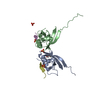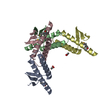| Entry | Database: PDB / ID: 6u19
|
|---|
| Title | Solution Structure of the RAZUL domain from 26S proteasome subunit hRpn10/S5a complexed with the AZUL domain from E3 ligase E6AP/UBE3A |
|---|
 Components Components | - 26S proteasome non-ATPase regulatory subunit 4
- Ubiquitin-protein ligase E3A
|
|---|
 Keywords Keywords | STRUCTURAL PROTEIN / proteasome / subunit / complex / ubiquitination |
|---|
| Function / homology |  Function and homology information Function and homology information
sperm entry / positive regulation of Golgi lumen acidification / regulation of ubiquitin-dependent protein catabolic process / prostate gland growth / proteasome accessory complex / HECT-type E3 ubiquitin transferase / proteasome regulatory particle, base subcomplex / Proteasome assembly / androgen receptor signaling pathway / progesterone receptor signaling pathway ...sperm entry / positive regulation of Golgi lumen acidification / regulation of ubiquitin-dependent protein catabolic process / prostate gland growth / proteasome accessory complex / HECT-type E3 ubiquitin transferase / proteasome regulatory particle, base subcomplex / Proteasome assembly / androgen receptor signaling pathway / progesterone receptor signaling pathway / polyubiquitin modification-dependent protein binding / postsynaptic cytosol / protein K48-linked ubiquitination / protein autoubiquitination / ovarian follicle development / negative regulation of TORC1 signaling / proteasome complex / response to progesterone / positive regulation of protein ubiquitination / regulation of circadian rhythm / brain development / regulation of synaptic plasticity / protein polyubiquitination / ubiquitin-protein transferase activity / synaptic vesicle / ubiquitin protein ligase activity / rhythmic process / Antigen processing: Ubiquitination & Proteasome degradation / ubiquitin-dependent protein catabolic process / molecular adaptor activity / proteasome-mediated ubiquitin-dependent protein catabolic process / transcription coactivator activity / positive regulation of phosphatidylinositol 3-kinase/protein kinase B signal transduction / glutamatergic synapse / positive regulation of transcription by RNA polymerase II / proteolysis / RNA binding / zinc ion binding / nucleoplasm / identical protein binding / nucleus / cytosolSimilarity search - Function Ubiquitin-protein ligase E3A, N-terminal zinc-binding domain (AZUL) / GTP Cyclohydrolase I; Chain A, domain 1 / Ubiquitin-protein ligase E3A / Ubiquitin-protein ligase E3A, N-terminal zinc-binding domain / Ubiquitin-protein ligase E3A, N-terminal zinc-binding domain superfamily / Amino-terminal Zinc-binding domain of ubiquitin ligase E3A / Ubiquitin-protein ligase E3B/C / : / Ubiquitin interaction motif / Proteasome subunit Rpn10 ...Ubiquitin-protein ligase E3A, N-terminal zinc-binding domain (AZUL) / GTP Cyclohydrolase I; Chain A, domain 1 / Ubiquitin-protein ligase E3A / Ubiquitin-protein ligase E3A, N-terminal zinc-binding domain / Ubiquitin-protein ligase E3A, N-terminal zinc-binding domain superfamily / Amino-terminal Zinc-binding domain of ubiquitin ligase E3A / Ubiquitin-protein ligase E3B/C / : / Ubiquitin interaction motif / Proteasome subunit Rpn10 / Ubiquitin-interacting motif. / HECT domain / HECT, E3 ligase catalytic domain / HECT-domain (ubiquitin-transferase) / HECT domain profile. / Domain Homologous to E6-AP Carboxyl Terminus with / von Willebrand factor type A domain / Ubiquitin interacting motif / Ubiquitin-interacting motif (UIM) domain profile. / VWFA domain profile. / von Willebrand factor (vWF) type A domain / von Willebrand factor, type A / von Willebrand factor A-like domain superfamily / Helix non-globular / SpecialSimilarity search - Domain/homology |
|---|
| Biological species |  Homo sapiens (human) Homo sapiens (human) |
|---|
| Method | SOLUTION NMR / simulated annealing |
|---|
 Authors Authors | Chen, X. / Walters, K.J. |
|---|
| Funding support |  United States, 1items United States, 1items | Organization | Grant number | Country |
|---|
| National Institutes of Health/National Cancer Institute (NIH/NCI) | 1 ZIA BC011490 |  United States United States |
|
|---|
 Citation Citation |  Journal: Nat Commun / Year: 2020 Journal: Nat Commun / Year: 2020
Title: Structure of E3 ligase E6AP with a proteasome-binding site provided by substrate receptor hRpn10.
Authors: Buel, G.R. / Chen, X. / Chari, R. / O'Neill, M.J. / Ebelle, D.L. / Jenkins, C. / Sridharan, V. / Tarasov, S.G. / Tarasova, N.I. / Andresson, T. / Walters, K.J. |
|---|
| History | | Deposition | Aug 15, 2019 | Deposition site: RCSB / Processing site: RCSB |
|---|
| Revision 1.0 | Mar 18, 2020 | Provider: repository / Type: Initial release |
|---|
| Revision 1.1 | Mar 25, 2020 | Group: Database references / Category: citation / citation_author
Item: _citation.journal_volume / _citation.page_first ..._citation.journal_volume / _citation.page_first / _citation.page_last / _citation.pdbx_database_id_PubMed / _citation.title / _citation_author.identifier_ORCID / _citation_author.name |
|---|
| Revision 1.2 | May 20, 2020 | Group: Structure summary / Category: struct / Item: _struct.title |
|---|
| Revision 1.3 | Jun 14, 2023 | Group: Database references / Other / Category: database_2 / pdbx_database_status
Item: _database_2.pdbx_DOI / _database_2.pdbx_database_accession / _pdbx_database_status.status_code_nmr_data |
|---|
| Revision 1.4 | May 22, 2024 | Group: Data collection / Category: chem_comp_atom / chem_comp_bond |
|---|
|
|---|
 Yorodumi
Yorodumi Open data
Open data Basic information
Basic information Components
Components Keywords
Keywords Function and homology information
Function and homology information Homo sapiens (human)
Homo sapiens (human) Authors
Authors United States, 1items
United States, 1items  Citation
Citation Journal: Nat Commun / Year: 2020
Journal: Nat Commun / Year: 2020 Structure visualization
Structure visualization Molmil
Molmil Jmol/JSmol
Jmol/JSmol Downloads & links
Downloads & links Download
Download 6u19.cif.gz
6u19.cif.gz PDBx/mmCIF format
PDBx/mmCIF format pdb6u19.ent.gz
pdb6u19.ent.gz PDB format
PDB format 6u19.json.gz
6u19.json.gz PDBx/mmJSON format
PDBx/mmJSON format Other downloads
Other downloads 6u19_validation.pdf.gz
6u19_validation.pdf.gz wwPDB validaton report
wwPDB validaton report 6u19_full_validation.pdf.gz
6u19_full_validation.pdf.gz 6u19_validation.xml.gz
6u19_validation.xml.gz 6u19_validation.cif.gz
6u19_validation.cif.gz https://data.pdbj.org/pub/pdb/validation_reports/u1/6u19
https://data.pdbj.org/pub/pdb/validation_reports/u1/6u19 ftp://data.pdbj.org/pub/pdb/validation_reports/u1/6u19
ftp://data.pdbj.org/pub/pdb/validation_reports/u1/6u19 Links
Links Assembly
Assembly
 Components
Components Homo sapiens (human) / Gene: PSMD4, MCB1 / Production host:
Homo sapiens (human) / Gene: PSMD4, MCB1 / Production host: 
 Homo sapiens (human) / Gene: UBE3A, E6AP, EPVE6AP, HPVE6A / Production host:
Homo sapiens (human) / Gene: UBE3A, E6AP, EPVE6AP, HPVE6A / Production host: 
 Sample preparation
Sample preparation Movie
Movie Controller
Controller









 PDBj
PDBj




 HSQC
HSQC